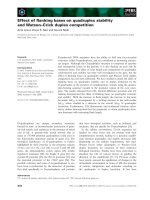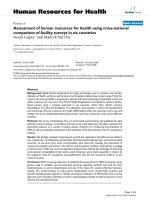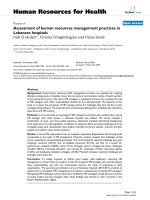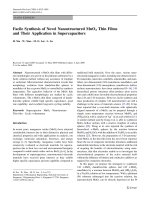Scientific report: "Assessment of genetic diversity of genetic resources Lilium spp. Indigenous and imported by RAPD directive" pptx
Bạn đang xem bản rút gọn của tài liệu. Xem và tải ngay bản đầy đủ của tài liệu tại đây (1.26 MB, 6 trang )
J. Sci. Dev. 2009, 7 (Eng.Iss.1): 30 - 35 HA NOI UNIVERSITY OF AGRICULTURE
30
Assessment of Genetic Variation in Local and Exotic
Lilium spp. Germplasm Using RAPD Markers
Đánh giá đa dạng di truyền nguồn gen Lilium spp. bản địa và
nhập nội bằng chỉ thị RAPD
Nguyen Thi Phuong Thao, Ninh Thi Thao, Vu Quang Khanh, Nguyen Quang Thach
Faculty of Biotechnology, Hanoi University of Agriculture
TÓM TẮT
Ở Việt Nam, ngoài loài hoa loa kèn trắng Lilium longiflorum, các giống Lily thuộc nhóm Oriental
và các con lai Asiatic đã đang trở nên rất phổ biến. Để thiết lập một chương trình chọn tạo giống
trong nước đối với loài hoa có giá trị kinh tế này, việc thu thập nguồn gen với sự đa dạng di truyền
lớn là yêu cầu tiên quyết. Chỉ thị RAPD đã được sử dụng để đánh giá sự đa dạng di truyền của 32
mẫu giống đại diện của các loài/ giống Lilium bản địa và nhập nội khác nhau. Trong số 20 mồi RAPD
sử dụng, chỉ có 3 mồi (chiếm 15%) là các mồi cho đa hình. Ba mồi OPA10, P615 và P650 đã tạo ra
được tổng số 123 băng DNA với trung bình đạt 0,8; 1,7 và 3,8 băng DNA tính trên mỗi mẫu giống
nghiên cứu. Mức độ đa hình khác nhau được thể hiện bởi 3 mồi này cũng đã quan sát được ở các
nhóm Lilium khác nhau. Số băng DNA đa hình cao nhất với 61 băng thu được ở nhóm chứa các
giống Lily thuộc nhóm Oriental đạt 49,59%, tiếp sau đó là nhóm L. longiflorum và các con lai của
chúng đạt 33,3%, nhóm các loài Lily hoang dại thu thập từ Nhật Bản đạt 8,13%; nhóm các giống lily
thuộc nhóm Asiatic đạt 7,32% và nhóm các loài lily bản địa của Việt Nam đạt 1,63%. Phân tích RAPD
cùng với việc thiết lập cây phân loại di truyền đã cho thấy sự đa dạng và mối quan hệ di truyền giữa
các nguồn gen Lilium đã thu thập.
Từ khoá: Chỉ thị DNA, đa dạng di truyền, đa hình DNA, Lilium, PCR, RAPD.
SUMMARY
In Vietnam, apart from Lilium longiflorum, Oriental lilies and its Asiatic hybrids have become
very popular. To set up a breeding program for this high economic value crop in the country,
collection of germplasm with a broad genetic variation is a prerequisite for the success. Random
amplified polymorphic DNA (RAPD) markers were utilized for the identification of genetic variation
of 32 representative samples of different local and exotic Lilium species and cultivars. Of the 20
primers, only 3 primers (15%) showed to be informative primers that generated polymorphic
patterns of PCR products. A total of 123 DNA bands were obtained with primers OPA10, P615 and
P650 giving an average of 0.8; 1.7 and 3.8 DNA bands per plant accession respectively. Different
level of genetic polymorphism as revealed by these 3 informative RAPD primers was found among
different Lilium groups. The highest polymorphic DNA bands were obtained in group containing
commercial Oriental Lilies with total 61 bands (49.59%), following by group of L. longiflorum and
their hybrids (33,3%), group of wild species from Japan; (8.13%), group of commercial Asiatic Lilies
(7.32%) and group of wild species from Vietnam (1.63%). RAPD analysis combined with the
construction of phylogenetic tree revealed the genetic variation and genetic relationship between
collected Lilium germplasm.
Key words: DNA markers Lilium, DNA polymorphism, genetic variation, PCR, RAPD.
Assessment of genetic variation in local and exotic Lilium spp.
31
1. INTRODUCTION
In Vietnam, apart from Lilium longiflorum
(so called "hoa loa kÌn tr¾ng" in Vietnamese),
Oriental and Asiatic lilies, and their hybrids,
have become very popular. Remarkably, so far
Vietnam has been reported to possess three wild
species which belong to genus Lilium including
Lilium brownii F.E Brown, Lilium poilanei
Gagn. and Lilium arboricola. Among them, L.
poilanei and Lilium arboricola have been
become very rare species in the world.
To set up a breeding program for this high
economic value crop in country, collections of
germplasm with a broad genetic variation is a
prerequisite for the success. Information on genetic
relationship is very important in designing crop
improvement program and management of
germplasm.
Different marker techniques (Yamagishi,
1995; Fernandez et al., 1996; Niimi et al., 1996;
Roh et al 1996; Van der Meulen et al1996; Obata ,
et al., 2000; Marasek and Orlikowska, 2001; Abe et
al., 2002) have been used for studies of genetic
differentiation in Lilium populations, identification
of cultivars and varieties, introgression studies,
determination of parentage, phylogenetic analysis,
and construction of genetic maps.
Among them Random amplified polymorphic
DNA (RAPD) markers is particularly well suited to
high-output systems required for plant breeding
because it is easy to perform, fast, reliable and of
relatively low cost (Williams et al., 1990). This has
been used in many studies e.g. identifying Lilium
genotypes (Fern¸ndez et al., 1996; Lee et al. 1996;
Choi et al., 1999; Obata et al., 2000; Yamagishi
2002); determining the hybridism of inter-specific
hybrids (Yamagishi, 1995; Obata et al., 2000;
Ploszaj et al. 2005; Wiejacha et al., 2001); assisting
in breeding program for disease resistance (Van
Heusden, 2001; detecting somaclonal variation of in
vitro propagated plants (Chia-Szu Wen and Ju-Ying
Hsiao. 1999; Varshney et al., 2001).
The present study was undertaken to assess the
genetic diversity of local and exotic germplasm of
Lilium using RAPD markers and the reliable
information obtained may serve as a reference for
plant breeding, gene pool diversity, and germplasm
conservation programs.
2. MATERIALS AND METHODS
2.1. Plant materials
A total of 32 Lilium accessions were used for
the study (Table 2).
These were categorized into 5 major groups A:
Lilium longiflorum and their hybrids; B: wild
species from Vietnam; C: wild species from Japan;
D: commercial Oriental Lilies and E: commercial
Asiatic Lilies.
2.2. Methods
RAPD-PCR: DNA was isolated from the leaves
of juvenile plants growing in the Greenhouse using
method of Nobuo Kobayashi (1998). In PCR-RAPD
reactions, 20 primers, whose sequences are given in
Table 1, were used. PCR was performed in a 20 ml
reaction solution containing 10x PCR buffer, 40 ng
of total DNA, 3 mM MgCl2, 200 mM each dNTP,
0.2 mM primer and 0.5 unit Taq DNA polymerase
(Fermentas). PCR program was set for each primer
following the instruction of references (Table 1). The
amplified fragments were electrophoresed in 2%
agarose gels (Quiagen, USA) followed by ethidium
bromide staining. All amplification reactions were
repeated at least three times.
3. RESULTS AND DICUSSION
Of the 20 primers, only 3 primers (15%)
showed to be informative primers that generated
polymorphic patterns of PCR products. A total of
123 DNA bands were obtained with primers
OPA10, P615 and P650 giving an average of 0.8;
1.7 and 3.8 DNA bands per one plant accession
respectively. Figure 1. showed the example of
RAPD markers generated by OPA-10.
Ten-base random primers have usually been
used for RAPD analysis in plant species. However,
Yamagishi (1995) reported that the efficiency of
10-base primers to produce polymorphic bands was
low in Lilium, i.e., 16% of the 10-base primers
produced polymorphic fragments among 13 species
and 16 inter-specific hybrids. In another study in
2002, Yamagishi et al. indicated that long random
primers have a high efficiency to produce DNA
markers in Lilium (12% of the 10-base primers
amplified polymorphic fragments between the two
Asiatic hybrid lily cultivars and 54 and 67% of the
15- and 20-base random primers produced
polymorphic bands, respectively). In our study
using different plant clones and species, 2 out of 3
informative primers were 17-base random primers
accounting for 66,7 %. Long random primers might
be useful in a RAPD assay for Lilium species.
Nguyen Thi Phuong Thao, Ninh Thi Thao, Vu Quang Khanh, Nguyen Quang Thach
32
As seen in table 2, plant accessions were
categorized into 5 major groups A, B, C, D and E.
Different level of genetic polymorphism as revealed
by these 3 informative RADP primers was found
among different groups. The highest polymorphic
DNA bands were obtained in Group D with total 61
bands (49.59 %), following by group A (33, 3 %), C
(8.13 %), E (7.32 %) and B (1.63 %). However,
three primers failed to produce any scorable band in
individual plant of Lilium longiflorum from Gialam,
Lilium poilanei Gagn. from Sapa, Lilium oriental
“Crystal Star” and Lilium asiatic hybrid “Quinta”
from the Netherlands and Lilium asiatic from Japan.
This might suggest the distinct DNA sequences of
these species.
Within group A of L. longiflorum, different
DNA bands were recorded indicating the genetic
variation have occured and they seemed to differ
from those lately imported such as Lilium
longiflorum “Deliana” or Lilium longiflorum
“Snow Queen”. In 2007, Trinh Thi Viet Chung also
detected the morphological variations among
population of L. longiflorum collected in different
locals in Vietnam. This might be the result of
selection and adaptation process of different clones
since L. longiflorum was the earliest cultivar that
has been introduced into Vietnam since 18 century.
Figure 2 showed the phylogenetic dendrogram
of 32 individual accessions with 3 informative
primers using the program NTSYSpc 2.02h. The
result showed that they can be divided in two major
groups which in turn can be divided into smaller
subgroups.The results of genetic analyses showed
that the local and exotic Lilium using in this study
is composed of genetically different clones. This
would offer possibilities for identifying the
germplasm collections, including material for a
breeding program in the country.
Table 1. Primers used in RAPD analysis, their sequence and references
Primers names Nucleotid sequence 5’-3’ Primer anneal temparature (
0
C) References
OPA-01 CAGGCCCTTC 32 Anushri Varshney (2001)
OPA-10 GTGATCGCAG 32
OPC-6* CAGGCCCTTC 33 (random selected)
OPA-04 AATCGGGCTG 32 Pham Thi Minh Phuong (2006)
OPG-10 AGGGCCGTCT 34
OPG-12 CAGCTCACGA 34
A8 GTGACGTAGG 32 Wen and Hsiao (1999)
A9 GGGTAACGCC 30
C5 GATAACCGCC 34
C11 AAAGCTGCGG 34
D3 GTCGCCGTCA 32
D5 TGAGCGGACA 30
Q5 CCGCGTCTTG 32
Q6 GAGCGCCTTG 32
V10 GGACCTGCTG 36
P615 GCCGTGGACTGCAGA 50 Yamagishi et al.(2002)
P617 CCCGACACCAGGTGA 50
P618 TCAGGTTATCCGCCCC 48
P623 ACGGGGTTTACCGCT 48
P650 GACACGGCCCGATAG 50
Assessment of genetic variation in local and exotic Lilium spp.
33
Table 2. List of plant materials and number of amplified products obtained
with primer OPA10, P615 and P650
Number of amplified products
Name of species and hybrids Origin
OPA10 P615 P650
Total
A Lilium longiflorum and their hybrids
2 Lilium longiflorum 1 Quang Ba, Vietnam 0 3 0 3
28 Lilium longiflorum5 Gialam, Vietnam 0 0 0 0
6 Lilium longiflorum 3 Namdinh, Vietnam 2 3 0 5
18 Lilium longiflorum 4 China 3 0 2 5
5 Lilium longiflorum 2 Japan 5 2 0 7
15 Lilium longiflorum “Deliana” Japan 0 2 1 3
29 Lilium longiflorum “Georgia” Japan 2 3 5 10
30 Lilium longiflorum “Snow Queen” Japan 0 3 2 5
3 Lilium formolongo China 0 2 1 3
Subtotal 12 18 11 41 ( 33.3 % )
B Wild species from Vietnam
4 Lilium poilanei Gagn. Sa Pa - Vietnam 0 0 0 0
25 Lilium brownii Ha Giang-Vietnam 0 2 0 2
Subtotal 0 2 0 2 (1.63 %)
C Wild species from Japan
31 Lilium formosanum Japan 0 4 4 8
32 Lilium speciosum Japan 0 2 0 2
Subtotal 0 6 4 10 (8.13 %)
D Commercial Oriental Lilies
1 Lilium oriental “Nostalgia” The Netherlands 4 1 0 5
7 Lilium oriental hybrid “Cassandra” Japan 0 2 1 3
8 Lilium oriental “Sorbonne” The Netherlands 0 2 1 3
9 Lilium oriental “Gradisca” The Netherlands 1 3 2 6
10 Lilium oriental “Acapulco” The Netherlands 0 2 2 4
11 Lilium hybrid “Leslie” The Netherlands 0 3 1 4
12 Lilium oriental “Tiber” The Netherlands 3 1 0 4
13 Lilium oriental hybrid “Siberia” The Netherlands 0 3 1 4
14 Lilium oriental “Stargazer” The Netherlands 0 3 4 7
16 Lilium oriental “Crystal Star” The Netherlands 0 0 0 0
19 Lilium oriental “Giacondo” The Netherlands 1 1 1 3
20 Lilium oriental “Mondriann” The Netherlands 1 1 1 3
21 Lilium oriental “Valadores” The Netherlands 3 2 1 6
22 Lilium oriental hybrid “Salinas” The Netherlands 0 0 5 5
23 Lilium oriental hybrid “Shalloon” The Netherlands 0 2 2 4
Subtotal 13 26 22 61 (49.59%)
E Commercial Asiatic Lilies
17 Lilium asiatic hybrid “Royal Show” The Netherlands 0 2 1 3
26 Lilium asiatic hybrid “Freya” The Netherlands 0 2 4 6
27 Lilium asiatic hybrid “Quinta” The Netherlands 0 0 0 0
24 Lilium asiatic * Japan 0 0 0 0
Subtotal 0 4 5 9 (7.32 %)
Total 25 56 42 123
Average 0.8 1.7 1.3 3.8
Nguyen Thi Phuong Thao, Ninh Thi Thao, Vu Quang Khanh, Nguyen Quang Thach
34
Fig. 1. RAPD patterns generated by primer OPA-10 . Lanes M: 1 kb size marker; 1-32: L. oriental
“Nostalgia”; L. longiflorum 1;L. formolongo; L. poilanei Gagn.; L. longiflorum 2; L. longiflorum 3; L.
oriental hybrid “Cassandra”; L. oriental “Sorbonne”; L. oriental - trumpet “Gradisca”; L. oriental
“Acapulco”; L. hybrid “Leslie”; L. oriental “Tiber”; L. oriental hybrid “Siberia”; L. oriental
“Stargazer”; L. longiflorum “Deliana”; L. oriental “Crystal Star”; L. asiatic hybrid “Royal Show” ; L.
longiflorum 4; L. oriental “Giacondo”; L. oriental “Mondriann”; L. oriental “Valadores”; L. oriental
hybrid “Salinas”; L. oriental hybrid “Shalloon”; L. asiatic; L. brownii; L.asiatic hybrid “Freya”; L.
asiatic hybrid “Quinta”; L. longiflorum 5; L. longiflorum “Georgia”; L. longiflorum “Snow Queen”; L.
formosanum;L. speciosum
Fig.2. Dendrogram obtained from RAPD pattern of 27 Lilium accessions
4. CONCLUSION
Obviously with the ever-increasing
production of new cultivars, the importance of
accurate tools for assessing the genetic
background and species or cultivar genuineness
has become more important.
M 16 15 14 13 12 11 10 9
8 7 6 5 4 3 2 1
M 32 31 30 29 28 27 26 25
24 23 22 21 20 19 18 17
Assessment of genetic variation in local and exotic Lilium spp.
35
The RAPD technique provides a useful
approach for evaluating genetic differentiation,
particularly in Lilium species, which is still poorly
known genetically. In this work, RAPD analysis
combined with the construction of phylogenetic
tree revealed the genetic variation and genetic
relationship between the local and exotic lily
cultivars and certain wild lily species from
Vietnam. However, more efficient primers will be
required to bring more reliable information which
will asset the breeding program for Vietnam its self
using valuable indigenous germplasm such as L.
poilanei and L. aboricola.
Acknowledgements
This research was supported by fundamental
scientific research in life science program code
number 6 006 08 (2006-2008) from the Ministry of
Science and Technology.
REFERENCES
Abe, H., Nakano, M., Nakatsuka, A., Nakayama, M.,
Koshioka, M., Yamagishi, M., (2002). Genetic
analysis of floral anthocyanin pigmentation traits
in Asiatic hybrid lily using molecular linkage
maps. Theor. Appl. Genet. 105, 1172–1182.
Choi, H.S., Kim, K.S., Choi, J.K., Lee, K.K., Hong,
D.K., Kang, W.H. and Lee, Y.S. (1999).
Classification of Lilium using random amplified
polymorphic DNA (RAPD). Korean J.Hort. Sci.
17:144-147.
Fernández, A.M., Nakazaki, T. and Tanisaka, T.
(1996). Development of diploid and triploid
interspecific hybrids between Lilium longiflorum
and L. concolor by ovary slice culture. Plant
Breed. 115:167-171.
Lee, J.S., Lee, P.O., Lim, Y.P., Shin, E.M., Park,
S.Y. and Roh, M.S. (1996). Classification of lilies
using Random Amplified Polymorphic DNA
(RAPD) analysis. Acta Hort. 414:137-144.
Marasek, A. and Orlikowska, T. (2001).
Identification of distant lily on the basis of
chromosal markers. (in Polish with English
summary). Biotechnologia 3 (54):243-248.
Niimi, Y., Nakano, M. and Maki, K. (1996).
Production of interspecific hybrids between L.
regale and L. rubellum via ovule culture. J.
Japan. Soc. Hort. Sci. 64:919-925.
Nobuo Kobayashi (1998). “A simple and efficient
DNA extraction Method for plants, Especially
woody plants”. Plant tissue culture and
biotechnology. June 1998 Vol.4 No.2.
Obata, Y., Niimi, Y., Nakano, M., Okazaki, K.,
Miyajima, I., (2000). Interspecific hybrids
between Lilium nobilissimum and L. regale
produced via ovules with placental tissue culture.
Scientia Hortic. 84, 191–204.
Pham Thi Minh Phuong, Shiro Isshiki and Yosuke
Tashiro (2006). Genetic Variation of Shallot
(Allium cepa L. Aggregatum Group) in Vietnam
(J. Japan. Soc. Hort. Sci.) 75 (3): 236–242. 2006.
Ploszaj, B., Stojalowski S. ,Startek L. and
Zawadzinska, A. (2005). Distant Hybrids and Their
Verification by Means of RAPD. Proc. IXth Intl.
Symp. on Flower Bulbs. Acta Hort. 673, ISHS.
Roh, M.S., Griesbach, R.J., Lawson, R.H. and Gross,
K.C. (1996). Production and identification of
interspecific hybrids of Lilium longiflorum and L.
elegans. Acta Hort. 414:93-101.
Trinh Thi Nhat Chung (2007). Study on dormancy
breaking of lilium bulbs and evaluation of genetic
variation lilium spp germplasm in Vietnam.
Master Thesis. 107 p.
Van der Meulen, J.J.M., J.C. van Oeveren, J.M.
Sandbrink & J.M. van Tuyl, (1996). Molecular
markers as a tool for breeding for flower longevity in
Asiatic hybrid lilies. Acta Horticulture 420: 68-71.
Van Heusden, AW, Jongerius MC, JM Van Tuyl,
TP Straathof & JJ Mes (2002). Molecular
assisted breeding for disease resistance in lily.
Acta Hortic 572: 131-138.
Varshney A , Lakshmikumaran, M. Srivastava P.
S., and Dawan, V. (2001).Establishment of
genetic fidelity of in vitro-raised lilium bulblets
through rapd markers. In Vitro Cell. Dev. Biol.
Plant 37:227-231, March-April 2001 ® 2001
Society for In Vitro Biology 1054-5476/01.
Chia-Szu Wen and Ju-Ying Hsiao. 1999. Genetic
differentiation of Lilium longiflorum Thunb.var.
scabrum Masam. (Liliaceae) in Taiwan using
Random Amplified Polymorphic DNA and
morphological characters. Bot. Bull. Acad. Sin.
(1999) 40: 65.7
Wiejacha, K., Marasek, A., Sabala, I. and
Orlikowska, T. (2001). Molecular markers in
detection of distant hybrids in Lilium. Acta Hort.
546:281-285.
Williams, J.G.K., Kubelik, A.R., Livak, K.J., Rafalski,
J.A., Tingey, S.V., (1990). DNA polymorphisms
amplified by arbitrary primers are useful as genetic
markers. Nucl. Acids Res. 18, 6531–6535.
Yamagishi, M., (1995). Detection of section-specific
random amplified polymorphic DNA (RAPD)
markers in Lilium. Theor. Appl. Genet. 91, 830–835.
Yamagishi, M., Abe, H., Nakano, M. and Nakatsuka,
A. (2002). PCR - based molecular markers in
Asiatic hybrid lily. Scientia Hort. 96:225-234.









